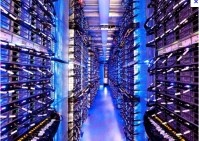Microsoft: Our datacenter offerings are software-defined, too

One of the buzzwords in heavy rotation at the VMworld show this week is "software-defined datacenter."

On Day 1 of the VMworld show, VMware played up the SDDC (software-defined datacenter) concept. "A software-defined datacenter is where all infrastructure is virtualized and delivered as a service, and the control of this datacenter is entirely automated by software," explained VMware Chief Technology Officer Steve Herrod in an August 27 blog post on the topic.
Not surprisingly, VMware isn't the only virtualization vendor employing the "software-defined" jargon.
In an August 22 blog post, Sandeep Singhal, GM of the Windows Networking team, and Vijay Tewari, Group Program Manager in the System Center Virtual Machine Manager (SCVMM) team, went proactive and talked ahead of the start of VMworld about Microsoft's Software Defined Networking (SDN) solution.
"By enabling network control via software, we give customers the ability to configure and reconfigure their networks to match the changing requirements of their workloads, without compromising multi-tenant isolation and performance that would be expected from traditional networking," explained the Softies in their post.
Which Microsoft products are at the heart of this software-defined datacenter approach? Windows Server 2012 and System Center 2012 SP1, Virtual Machine Manager (VMM). Within Windows Server 2012, Microsoft's Hyper-V hypervisor and the new Hyper-V Extensible Switch that is part of the latest Windows Server release, are the keys to Microsoft's SDN offering, Singhal and Tewari said.
Microsoft is using SDN to refer to products and technologies that
- enable admins to create virtual networks that run on top of physical networks
- create virtual networks dynamically and support virtual machine (VM) mobility while preserving the logical network abstraction
- control traffic flow within the datacenter, creating policies dynamically and adjusting them to specific workflows
- create policies spanning physical and virtual networks
"This definition of SDN is, in fact, broader, than the definition currently used by many industry players who only focus on configuration of physical network elements. Our broader SDN definition includes programmability of end hosts, enabling end-to-end software control in the datacenter. Our definition also supports real-time changes in response to VM placement and migration," blogged the aforementioned Microsoft execs.
It's not just in definitions where Microsoft parts ways from its cloud competitors (and, specifically VMware, which Singhal and Tewari never mentioned in their post by name.)
"We disagree with many in the industry who say that SDN should 'commoditize' the network infrastructure," the pair blogged. "In our view, SDN should provide the automation, flexibility, and control to allow you easily to take advantage of the capabilities of the infrastructure. "
Singhal and Tewari cited work done by Microsoft Research as influencing Redmond's (and the entire industry's) thinking about software-defined datacenters. They linked to a 2009 paper on a MSR project known as VL2 -- "a practical network architecture that scales to support huge data centers with uniform high capacity between servers, performance isolation between services, and Ethernet layer-2 semantics" -- as a key guide to SDN's evolution.
While on the topic of the Microsoft and VMware virtualization war, it's worth noting that VMware also announced at VMworld on August 27 that it is dropping its controversial virtual-RAM pricing and licensing model. Microsoft -- along with a number of VMware customers -- has been a vocal critic of the vSphere "tax" which VMware attempted to introduce by licensing around virtual RAM.